Search the Special Collections and Archives Portal
Search Results
Irene Fisher and Bobbie Gang oral history interview
Identifier
Abstract
Oral history interview with Irene Fisher and Bobbie Gang conducted by Barbara Tabach on September 29, 2016 for the Southern Nevada Jewish Heritage Project. Fisher discusses moving to Las Vegas, Nevada with her husband assigned to Nellis Air Force Base, and their two children. She also talks about joining the Sisterhood at Temple Beth Sholom and the Clark County Library District Board. Gang joins in to talk about volunteering, family, and raising children in Las Vegas.
Archival Collection
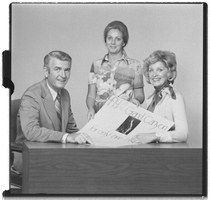
Photographs of Dorothy Eisenberg, February 24, 1975
Date
Archival Collection
Description
Dorothy Eisenberg, center, and other unidentified individuals. 120mm negatives.
Image

Dorothy Eisenberg interview, March 8, 2017: transcript
Date
Archival Collection
Description
Multicultural advancements in Las Vegas cannot be mentioned without speaking on the monumental contributions of Dorothy Eisenberg. From 1971 to 1998, she was involved with over 25 local organizations and committees and had the honor of having an elementary school named after her. Eisenberg’s beginnings start in the midst of the all American melting pot experience though immigration. Her mother came to the United States from Russia at age twelve and her father from Austria at age sixteen to go upholstery school. Upon marriage, they settled down in Philadelphia after the World War II. They raised Dorothy and her siblings to contribute to the community despite the anti-Semitism that was displayed there on a regular basis. Signs that said, “No dogs and Jews allowed” were common place. After her first husband died, leaving her as a single mother of four little girls, she didn’t allow herself to be trampled by her circumstances by enrolling in Temple University to be a teacher at a time when the university had stigma towards older students. Upon her marriage to her second husband, the family moved to Las Vegas where she found a spiritual home for her family at Temple Beth Sholom, where her children went learned to deeply appreciate their Jewish heritage and attended Hebrew school. Having always been involved with politics in Philadelphia, she faced personal discrimination due to her religion when she was searching for organizations to involve her time. She eventually found a home with the League of Women Voters in 1965 and became involved with the Observers Corp and became aware of what was going on with the African American community from community based research and dialogue. She played a key role as president of the organization and faced heat for her involvement in the desegregation of sixth grade centers with the Kelly vs. Guinn decision in 1972 and was involved with the Welfare Rights Movement. She met Ruby Duncan and Jane Fonda, and she even showed up to the march with her daughters. Eisenberg was heavily involved with her namesake school through meetings with principals at least once a year, reading to students in the classroom, and bringing latkes to the school on Hanukkah. She continues the intergenerational legacy of educational involvement set forth by her parents with supporting her children, grandchildren and great grandchildren in the school as well. Dorothy Eisenberg is a true role model for Nevada and a pioneer for equal education in Las Vegas.
Text

Transcript of interview with Dr. Leonard Kreisler by Barbara Tabach, May 23, 2016
Date
Archival Collection
Description
Dr. Leonard Kreisler, MD, was born August 3, 1930 in Brooklyn to post World War I European Jewish immigrants. Raised in the smaller community of White Plains, New York, he worked happily by his father?s side. The elder Kreisler was a cabinet maker and carpenter, who Len describes as fiercely independent. Young Len keenly helped his Yiddish language father write his contracts and guided him to increasing his prices. At an early age, Len knew that he would become a medical doctor?little did he know what an amazing life was in his future. It was while attending the University of Vermont, College of Medicine that Len met his wife Joan. They married in June 1957. Joan became a teacher and later a real estate agent while in Las Vegas. This interview includes stories about his medical education and his thirteen year private medical practice in Peekskill, New York. This was followed by a career in occupational medicine and over seventeen years as the Medical Director at the Nevada Test Site for Reynolds Electric and Engineering Corporation (1973 ? 1990). During that time he was also elected Chief of Staff at University Medical Center (UMC) for two years and helped create the Children?s Miracle Network Telethon and the UMC Foundation. When he recalls moving to Las Vegas, his memories include jogging by Temple Beth Sholom and joining a minyan. He became a congregation vice president. When his career at the Test Site was halted, his medical adventure led him to be a maritime physician for a cruise liner. He also ran twice for Clark County Commissioner against Thalia Dondero. Dr. Kreisler is the author of several books: Death by Any Means (2005); Roll the Dice, Pick a Doc and Hope for the Best (2009); The Codes of Babylon (2010); Shortfall (2011); The Obligated Volunteer (2014) and In Bed Alone, A Caregiver?s Odyssey (2016).
Text
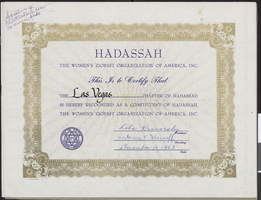
Hadassah certificate of constituency for the Las Vegas Chapter, December 16, 1963
Date
Archival Collection
Description
Certificate of constituency issued for the Las Vegas Chapter of Hadassah in 1963, with signatures of charter members on the reverse.
Text
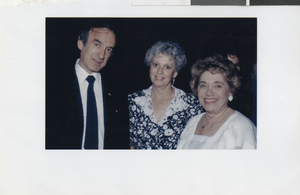
Photograph of Elie Wiesel, Dorothy Eisenberg and Edythe Katz, 1980s
Date
Archival Collection
Description
Color photograph of Elie Wiesel, Dorothy Eisenberg and Edythe Katz.
Image
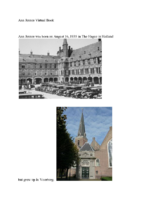
Biographical essay by Ann Jenner, 2014
Date
Archival Collection
Description
Jenner's essay describes her family's experience in hiding in Holland during World War II.
Text
Flora Mason oral history interview
Identifier
Abstract
Oral history interview with Flora Mason conducted by Barbara Tabach on December 08, 2014 and January 17, 2017 for the Southern Nevada Jewish Heritage Project. Mason discusses living in Las Vegas, Nevada since 1965 with her husband, Stuart Mason. Mason also discusses her involvement with the Temple Beth Sholom, the Foundation at the University of Nevada, and various Las Vegas libraries.
Archival Collection
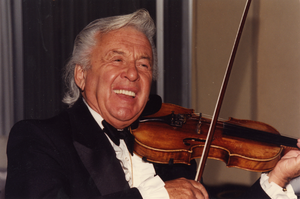
Photograph of Sasha Semenoff, 1990s
Date
Archival Collection
Description
Sasha Semenoff playing the violin at a Jewish Federation event.
Image
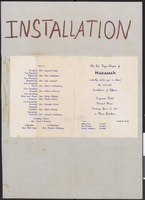
Scrapbook pages from the Las Vegas Chapter of Hadassah, 1971-1972
Date
Archival Collection
Description
These scrapbook pages are from the Las Vegas Chapter of Hadassah for the years 1971 and 1972. The pages contain event announcements, invitations, photographs, and newspaper clippings about Hadassah events.
Mixed Content
